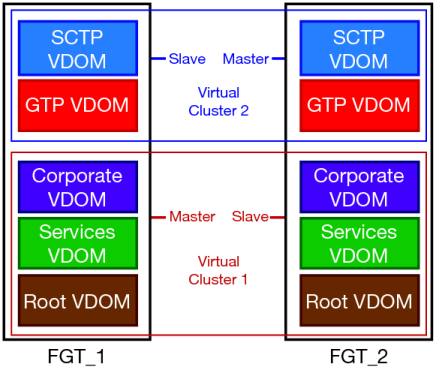SCTP example scenario
An ideal SCTP configuration for a Carrier serving multiple operators/service providers involves a unified Firewall, securing all incoming and outgoing traffic over the Carrier network, whether it be standard web traffic, GTP or other carrier traffic, or corporate traffic for the Carrier company.
One best practice method to provide a unified firewall with built-in redundancy is to make use of multiple FortiGate units, connected in a High Availability cluster. Also, there are additional methods that can be applied to ease the complexity of managing multiple services, functions, and traffic types across multiple devices.
Figure 147: Sample SCTP Network Topology
In this example, the firewall layer is configured with two FortiGate devices to act as an HA cluster, providing automatic load balancing and failover detection for the main firewall.
The two devices together make up the firewall, through which all traffic passes. Virtual Domains are created within the FortiGate units, distributing services and traffic into individual VDOMs, allowing them to be monitored and secured individually, to help mitigate possible threats to Carrier networks that target specific services. Individual departments or administrators can manage specific VDOMs, or the FortiGates can be collectively managed centrally by network administrators.
The VDOMs are distributed as below:
Figure 148: VDOM distribution between SCTP Firewall Layer FortiGate units
One FortiGate handles basic FortiGate services and non-Carrier traffic. Configuring virtual clustering across the two FortiGates allows one to mirror its VDOMs across to the other unit.
The second FortiGate can then primarily provide Carrier-specific services and handle SCTP, Gi and GTP traffic, using the first FortiGate as the slave unit in a second virtual cluster.


